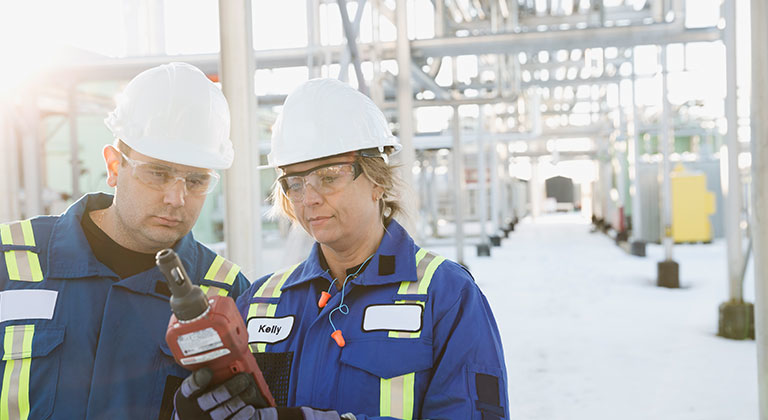Avoid carbon monoxide
An invisible danger—a visible solution
Carbon monoxide (CO) is a colorless, odorless gas produced by the incomplete burning of organic materials, such as coal, wood, gas, oil, charcoal, and gasoline. It can be a danger to your workers. But there are things you can do to help them avoid exposures.
CO is absorbed only through the lungs, where it enters the blood stream the same way as oxygen. It affects several different organs in the body—but has its most profound impact on the brain and heart, since they use the most oxygen.
How severely workers are affected depends upon the level of carbon monoxide, the amount of oxygen in the air, the room temperature, how strenuous the work being done is, the health and smoking habits of the exposed worker, altitude, and the simultaneous exposure to other toxic materials like solvents.
Exposure limits
OSHA has established a Permissible Exposure Limit (PEL) for carbon monoxide of 50 ppm (parts per million) as an eight-hour Time Weighted Average (TWA). The American Conference of Governmental Industrial Hygienists has a recommended Threshold Limit Value of 25 ppm as an eight-hour TWA.
Watching for symptoms
There are several symptoms of carbon monoxide poisoning you can watch for. Early signs include:
A sensation of tightness across the forehead
Weakness
Dizziness
Heavy beating of the heart
Flushing of the face
Eyes appearing bright red
Nausea and vomiting may also occur
In serious exposures, the legs may become paralyzed, causing the worker to fall and be unable to rise or even crawl. In exposures where concentration of the gas is extremely high, unconsciousness may occur immediately without any warning symptoms. In either case, if emergency care isn’t given quickly, it can become deadly.
CO poisoning is an even a bigger concern in winter months—especially when more than one person in a group experiences:
Malaise, flu-like symptoms, or fatigue
Chest pain, palpitations
Confusion
Depression
Impulsiveness
Distractibility
Hallucinations
Agitation
Abdominal pain
Headache
Drowsiness
Memory and balance issues
Helping those exposed
Carbon monoxide poisoning requires fast medical treatment. You should move the person outside for fresh air and begin artificial respiration. Call for medical help and keep the person moderately warm with a blanket. Elevate their feet higher than their head. Don’t let them move without medical approval, since extra exertion could make things worse.
Checking for CO
When it comes to carbon monoxide exposures, you need to monitor workers and their work environment. You can measure CO with a portable direct reading carbon monoxide meter which has been calibrated, or with an appropriate gas detector tube or passive dosimeter.
Preventing carbon monoxide poisoning
To bring carbon monoxide concentrations to acceptable levels, you can use general ventilation already in place. In some areas, a ventilation system can be designed to operate under negative pressure to ensure carbon monoxide is not sent into nearby work areas or office spaces. If your ventilation system isn’t designed to work under negative pressure, air flow should travel along a pathway from non-contaminated areas to contaminated areas, then exhausted outside.
To cut down on the risk, you should do the following:
Never use a generator inside an enclosed structure
Properly install, maintain, and operate all fuel-burning appliances
Have heating systems and chimneys annually inspected by a licensed contractor
Inspect and tune vehicle exhaust systems each year
Never use a charcoal grill, hibachi, gas-fueled lantern, or portable camping stove inside an enclosed area
Use electric or air-powered tools instead of gasoline powered equipment in enclosed areas
If a gas powered tool or equipment must be used in a partially enclosed area such as a construction site, fans or mechanical ventilation systems should supply fresh air to the area
Install an Underwriters Laboratory (UL) listed CO detector and replace batteries twice a year
Never leave the motor running of a vehicle parked in an enclosed or semi-enclosed area
By following these steps, you can reduce the risk of carbon monoxide poisoning in your workplace and help keep workers safe and productive.
Related resources
Avoid bad wiring and the fire danger it presents
Electricity is one of the top causes of fire at a business. We have some tips to help you identify the hazards and make the fixes before something happens.
Effective safety meetings
Safety meetings are needed in every workplace. But how do you make sure they’re effective? We have some tips on how to help get the most out of yours.






